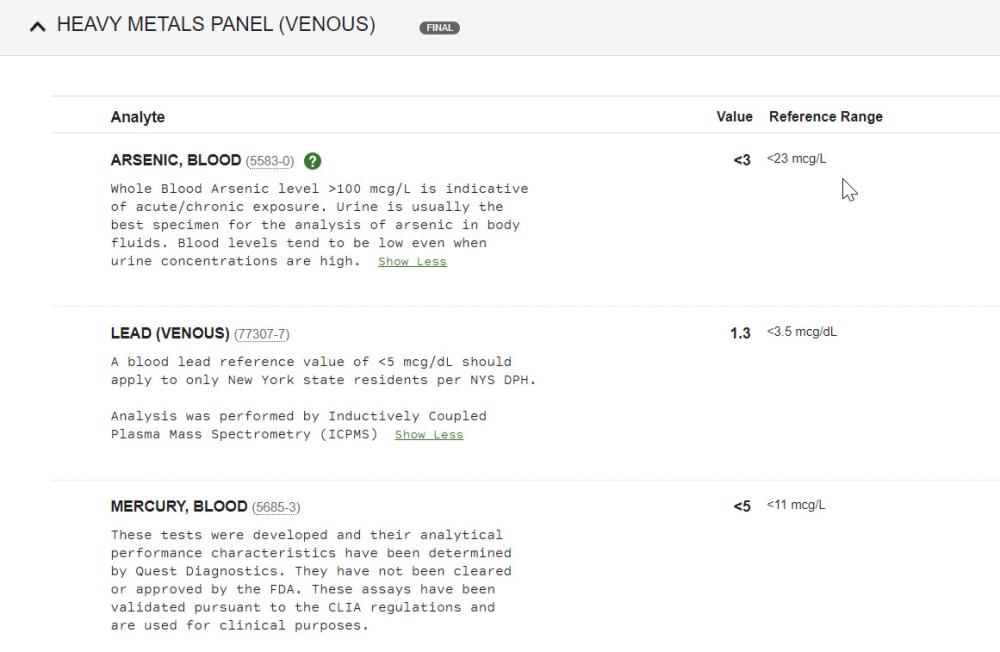Heavy Metals Test Profile , Blood: Arsenic, Lead and Mercury

This panel measures the blood levels of arsenic, lead, and mercury.
This panel measures the blood levels of arsenic, lead, and mercury.
The patient should avoid seafood and red wine 72 hours before collection.
Heavy Metals Test Profile , Blood: Arsenic, Lead and Mercury
Heavy metal toxicity is a growing concern in today's world. Heavy metals, such as arsenic, lead, and mercury, can accumulate in the body over time and cause serious health problems. A heavy metals test profile measures the amount of these toxic substances in your blood, providing you with important information about your overall health. In this blog post, we will discuss the importance of a heavy metals test profile and how it can help you identify potential health risks. We will cover everything from how these heavy metals are ingested to what symptoms you should look out for. You will also learn about the procedure for collecting and testing blood samples for heavy metals, how to prepare for the test, and how to interpret your results. Finally, we will discuss treatment options and how you can purchase an affordable heavy metals test profile without visiting a doctor on DiscountedLabs.com.
The Importance of Heavy Metals Test Profile
Determining heavy metal toxicity in the body is crucial, and a comprehensive blood test can help achieve this. By identifying potential sources of heavy metal exposure, interventions can be targeted to minimize risk. Assessing the impact of heavy metal poisoning on overall health allows for early detection and prevention of related conditions. Additionally, clinicians can develop personalized treatment plans for heavy metal detoxification based on the test results. This comprehensive profile plays a vital role in maintaining public health by confirming contamination and ensuring prompt intervention.
Understanding the Role of Arsenic, Lead and Mercury in the Body
Arsenic, lead, and mercury play significant roles in the body, but they can also have detrimental effects when present in high levels. Arsenic is linked to cardiovascular diseases and an increased risk of cancer. Lead impairs neurological development, particularly in children. Mercury affects the nervous system and can lead to cognitive and behavioral issues. Each heavy metal has its own specific health implications and toxic effects. Understanding the role of each heavy metal is crucial for targeted treatment and prevention strategies. By identifying their presence and levels, healthcare professionals can develop personalized plans to address heavy metal toxicity.
How are Heavy Metals Ingested?
Heavy metals can be ingested through various means. Drinking water contaminated with heavy metals is a common source of exposure. Seafood consumption, especially fish and shellfish, can lead to the accumulation of mercury in the body. Occupational exposure in certain industries can occur through inhalation or skin contact. Ingesting lead particles from deteriorating paint, particularly lead-based paint, is another way heavy metals are ingested. Additionally, exposure to heavy metals can happen through common household products.
Common Sources of Arsenic, Lead, and Mercury
Arsenic can be found in pesticides, herbicides, and various industrial processes. Lead is often present in old pipes, lead-based paint, and certain occupations. Mercury can be found in thermometers, dental fillings, and contaminated seafood. Identifying these potential sources is crucial in reducing exposure and preventing heavy metal poisoning. Being aware of common sources of heavy metal poisoning allows individuals to take proactive measures to minimize the risk of exposure. By understanding where these heavy metals come from, people can make informed decisions about their environment and overall health.
What are the Symptoms of Heavy Metal Poisoning?
Symptoms of heavy metal poisoning include gastrointestinal issues like nausea, vomiting, and abdominal pain. Neurological symptoms may manifest as headaches, memory loss, and peripheral neuropathy. Cardiovascular problems, such as high blood pressure and shortness of breath, can also occur. Anemia, resulting in fatigue and reduced red blood cell production, is another common symptom. Recognizing these signs helps with early detection and prompt treatment.
Recognizing Signs of Arsenic, Lead, and Mercury Poisoning
Recognizing the signs of heavy metal poisoning is crucial for prompt diagnosis and treatment. Arsenic poisoning can manifest as skin changes, cardiovascular diseases, and gastrointestinal issues. Lead poisoning may result in developmental delays, behavioral changes, and anemia. Mercury poisoning can lead to neurological problems, tremors, and kidney damage. Each type of heavy metal poisoning exhibits distinct signs, aiding in accurate identification and targeted intervention. Early recognition of symptoms is essential for minimizing long-term health complications.
What Does a Heavy Metal Blood Test Involve?
A heavy metal blood test involves a simple venous blood draw for laboratory analysis. The collected blood specimen is processed through centrifugation to separate serum or plasma for testing. The test measures levels of arsenic, lead, and mercury in the blood, providing a comprehensive assessment of heavy metal exposure. Results are typically available within a few days.
Procedure for Blood Collection and Testing
To ensure an accurate assessment of heavy metal exposure, the procedure for blood collection and testing involves various steps. A trained professional, known as a phlebotomist, collects blood from a vein using a sterile needle in a process called phlebotomy. The collected specimen is then labeled properly and transported to the laboratory for analysis. Specialized equipment is used to measure heavy metal levels accurately in the blood sample. The results obtained are compared with established guidelines, known as the reference range, to determine if heavy metal exposure is within normal limits. Blood testing plays a crucial role in ensuring an accurate assessment of heavy metal exposure, helping individuals identify and address potential health risks associated with heavy metal contamination.
How to Prepare for a Heavy Metal Blood Test
To prepare for a heavy metal blood test, there are several important steps to keep in mind. Due to the potential impact of food intake on some heavy metals, fasting may be necessary first. It's also crucial to discuss any medications you're taking with your healthcare provider, as some medications can interfere with the test. Minimizing potential exposure to heavy metals prior to the test is important, such as avoiding contact with insecticides or ceramics. Lastly, be sure to follow any pre-test instructions provided by your healthcare provider, as adequate preparation ensures reliable and meaningful test results.
Pre-Test Instructions and Considerations
To ensure accurate results for certain heavy metals, it is important to follow specific fasting instructions. Additionally, inform your healthcare provider about all medications, including supplements, that you are taking, as they can interfere with the test. It is crucial to share any relevant symptoms or exposure history for a comprehensive assessment. Don't hesitate to discuss any concerns or questions with your healthcare provider before the test. Proper pre-test preparation is essential to obtaining reliable and meaningful results for your heavy metal blood test.
Risks Associated with the Heavy Metal Blood Test
The heavy metal blood test is a valuable tool for measuring levels of metals such as arsenic, lead, and mercury in the body. This test involves taking a blood sample, typically from a vein, to identify potential heavy metal exposure. While the test itself is generally safe, there are some possible risks to be aware of. These can include bruising or bleeding at the site where the blood is drawn. To minimize these risks and ensure accurate results, it is important to follow any preparation instructions provided by the testing facility.
Interpreting the Results of the Heavy Metal Blood Test
Results from the heavy metal blood test are typically reported in micrograms per deciliter (µg/dL). Elevated levels may indicate heavy metal poisoning or exposure. It's important to note that reference ranges can vary depending on the specific metal being tested. To accurately interpret these results, it is recommended to consult a healthcare provider. In some cases, further testing may be necessary to obtain a definitive diagnosis.
What if Your Test Shows High Levels of Heavy Metals?
If your test shows elevated levels of heavy metals, further evaluation may be necessary. A healthcare provider can assess your symptoms and medical history to determine the appropriate course of action. Treatment options may include chelation therapy to remove excess metals from the body and lifestyle changes to reduce exposure. Regular monitoring of blood levels may be recommended as well.
Can Heavy Metal Poisoning be Treated?
Treatment options for heavy metal poisoning vary depending on the specific metal involved. Chelation therapy is commonly used for certain heavy metals. Early detection and removal of the source of exposure are crucial, and personalized treatment recommendations should be sought from a healthcare provider. Follow-up testing may be necessary to monitor progress.
How to Buy an Affordable Heavy Metals Test Profile Without a Doctor's Visit on DiscountedLabs.com?
Looking to buy an affordable heavy metals test profile without a doctor's visit? Visit DiscountedLabs.com.
Conclusion
In conclusion, getting a Heavy Metals Test Profile is essential for identifying and addressing potential heavy metal poisoning in the body. Arsenic, lead, and mercury are common heavy metals that can have harmful effects on our health. It is important to understand the sources and symptoms of heavy metal poisoning in order to take the necessary precautions. The Heavy Metals Blood Test involves a simple procedure of blood collection and testing. Interpreting the results of the test is crucial, and if high levels of heavy metals are detected, further treatment may be necessary. To make the process more convenient and affordable, you can purchase a Heavy Metals Test Profile without visiting a doctor through DiscountedLabs.com. Take charge of your health and ensure the well-being of your body by being proactive about heavy metal testing.
HOW DOES DISCOUNTEDLABS.COM WORK?
-
Go to the "Find a Location" page to find the closest lab location. No need to make an appointment since walk-ins are welcomed. Once you have identified your closest location, go to step 2.
-
Go to "Choose a Test" and add your selection (s) in the shopping cart. If you prefer to save money on bundled tests, we have created "Lab Test Panels" that can help you decide what to order.
-
If you have a discount coupon code, add it to your cart.
-
A $8 lab processing fee will be added to your total.
-
Pay using a credit card.
-
You will receive an order confirmation and instructions email on how to download your lab request.
-
Print lab request form that you downloaded.
-
Take that form to the closest location. Get your blood drawn.
-
You will receive an email when the results are ready for you to download.
Note: You cannot place an order under someone else's profile. The profile person's name will appear on the lab order form.If you have further questions, please email [email protected].

